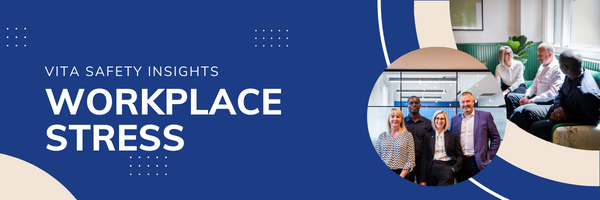
76% of UK professionals feel moderate to high levels of work stress.
To build an effective health and safety strategy, we must look at the bigger picture of workplace stress and risks. Both physical and emotional.
The role of health and safety is evolving to incorporate mental health and wellbeing. It isn’t just about fires and falls. Risk assessments and control measures need to be carried out to identify and manage wellbeing at work holistically.
Stress symptoms and causes
Stress is a leading workplace health hazard. According to the NHS, workplace stress can be caused by excessive workloads, poor management processes and bullying and harassment. Rigid working hours, job insecurity, insufficient support and a lack of recognition for good performance can further exacerbate stress levels among employees.
The World Health Organisation (WHO) also highlights how stress can significantly affect an individual’s quality of life, leading to various potential hazards, including:
- Prolonged psychological damage
- Impaired judgement
- Increased risk of accidents
- Substance abuse
- Physical health effects
- Sleep disturbances
A healthy and thriving workforce depends on the mitigation of these risks.
What does the law say?
Laws and regulations are in place to protect individuals and your business.
- Employers must make sure they’re following the Working Time Regulations (1998). This law sets rules for factors like working long hours and breaks and maximum weekly work hours.
- The Health and Safety at Work Act (1974) requires employers to protect their employees from the health, safety and welfare of their employees.
- The Management of Health and Safety at Work Regulations (1999) states all employers must undergo a ‘suitable and sufficient assessment’ of the risks to the health and safety of their employees at work.
This means that by law, employers must identify any risks to their employees’ health. Carry out risk assessments and take steps to prevent or reduce workplace stress.
How to reduce stress through a risk assessment
Stressed employees are more likely to take time off, resulting in decreased productivity and higher costs for the company in terms of sick leave and temporary replacements.
The best way to manage workplace stress is to spot and handle possible causes early on with a stress risk assessment.
A workplace stress risk assessment involves identifying:
- The primary causes of stress such as increased workload and managerial pressure.
- Who is most likely to be affected by stress such as junior employees taking on more responsibility or customer-facing teams.
- Your existing processes for managing workplace stress. Do you provide 1-1’s? Are there enough people on your team to manage the work?
- Those responsible for each procedure. Who oversees wellbeing at work? What processes are in place that need to be monitored?
By doing this, you’re prioritising employee wellbeing. Just like how you assess other health and safety risks.
The benefits of managing workplace stress
Effectively managing workplace stress mitigates risks associated with high-pressure environments. It can also enhance employee satisfaction, mental health and productivity.
By prioritising the emotional wellbeing of employees, employers directly address the concerns of the 20% of the workforce who view ‘wellbeing’ as their main workplace priority.
This alignment with employee values fosters a culture of support and understanding, which, in turn, promotes resilience and reduces the adverse effects of stress. Such an approach can not only improve morale and engagement but also lead to increased focus and efficiency among staff. Heightened productivity, coupled with a supportive workplace atmosphere, attracts and retains top talent, nurturing a positive organisational culture.
In essence, effectively managing workplace stress through a focus on emotional health signifies an organisation’s commitment to its employees’ holistic wellbeing. Ultimately contributing to the long-term success and sustainability of the business.
Not only this, but by managing workplace stress, employees are less likely to be off work with stress.
Securing a healthy future with stress risk assessments
Stress risk assessments are invaluable, not only enhancing the wellbeing of your employees but also contributing significantly to the health and longevity of your business (and society as a whole!).
Discussing this topic, we’ve covered:
- How stress risk assessments are just as important as any other assessment.
- Causes and signs of stress at work.
- Legalities surrounding wellbeing at work.
- Changes in society that require a new approach to emotional health at work.
- How assessments and action can reduce the risks associated with work stress.
Prioritise the mental health and wellbeing of your employees. Take the first step towards a safer, less stressful work environment and contact us today.
